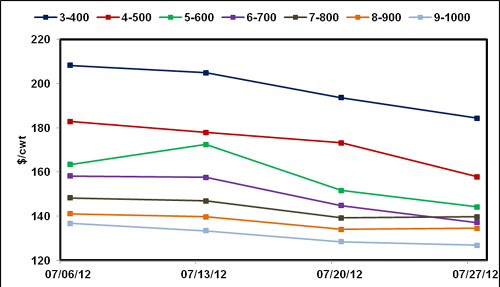



Iowa Cattle Market Situation and Outlook
With two reports released recently by the USDA observing cattle inventories, Lee Schulz from the University of Iowa looks at them in more detail.Mid-year Cattle Report
USDA released two reports estimating July 1, 2012 cattle inventories; the mid-year Cattle report and the July Cattle on Feed report. Table 1 contains a summary of the Cattle report. The total cattle and calves and cow inventory in the US were both down 2.2 per cent from a year ago. Beef cows were down 2.9 per cent, heifers for beef cow replacement were equal to a year ago, and the calf crop was down 2.3 per cent. This smaller inventory coupled with fewer cows and retention of heifers remaining at all-time lows indicates herd liquidation is continuing.

The total cattle on feed inventory was estimated at 12.3 million head, 0.8 per cent higher than a year ago. The number in feedlots with 1,000+ head capacity is estimated to be 10.7 million head, 2.7 per cent higher than 1 July 2011. It only happens twice a year that we get a total cattle on feed inventory and the monthly cattle on feed inventory (1,000+ head capacity). The monthly number up 2.7 per cent, compared to the bi-annual number up only 0.8 per cent from a year ago, suggests that we will continue to see the smaller feedlots exiting and downsizing their portion of the US cattle feeding business.
Placements in feedlots during June totaled 1.66 million, 1.5 per cent below a year ago. Moving forward we are likely to see increasing placement of heifers that were destined for the breeding herd purposes and mixed light-weight animals being forced into feed yards as a result of the drought.
In Iowa, cattle and calves on feed for all feedlots totaled 1,235,000 on 1 July 2012. The inventory is down 5 per cent from June 1, 2012 but up 2 per cent from 1 July 2011. Placements during June totaled 121,000 head, a decrease of 4 per cent from last month but up 6 per cent from last year. Marketings for June were 182,000 head, up 18 per cent from last month and up 1 per cent from last year.
Cattle inventories in the US have been dropping for years, but the pace picked up last year when ranchers in the Southwest liquidated herds amid a severe drought. Operations in the West and Midwest bought some of those cows, so nationwide, the loss wasn’t as great as it could have been. With this year’s drought, virtually no one is expanding herds and inventory estimates suggest further decline of the US herd.
Pasture and Range Conditions
The drought has had a dramatic impact on pasture and range conditions. For the week ending July 29, the USDA crop progress survey indicated that 57 per cent of pasture and ranges in the US were in poor to very poor condition. Last week 55 per cent of pastures and ranges were rated poor to very poor and last year at this time 36 per cent fell in this category. In Iowa, 82 per cent of pasture and ranges were rated poor to very poor (79 per cent last week and 18 per cent this time last year).
Currently, some 77 per cent of the US beef cow inventory is located in states where over forty percent of the pasture and ranges are in poor to very poor condition (table 2). Last year, just 40 per cent of the beef cow inventory was located in such states. The poor grazing conditions have led to cow herds being further reduced, static heifer retention, and calves being sold sooner and/or at lower weights.

Feeder Cattle Prices
Current cattle prices reflect underlying market signals as well as the direct impacts of this year’s drought. Much attention has been focused on how much cattle prices will be impacted. For feeder cattle, it is always important to consider changes in the price relationships across weights as well as the overall price levels. Recently, prices for lightweight feeder cattle have decreased more than prices for heavy feeder cattle. The decrease in heavy feeder cattle prices reflects primarily the impact of high corn prices on feedlot demand for cattle combined with the general demand weakness reflected in boxed beef prices.
Calf and stocker prices reflect all of those factors plus the lack of forage and limited opportunities for stocker based cattle production. As a result, the current price pattern is one in which feeder prices drop rapidly up to about 700 pounds (for steers) and then are relatively flat for heavier feeders.

This type of “inverted” feeder price structure occurs rarely and reflects the combined impacts of high corn prices and a relative excess of animals at the current time due to the drought. Notwithstanding current production difficulties, the market is providing strong signals to add weight to feeder cattle before feedlot placement.
August 2012

